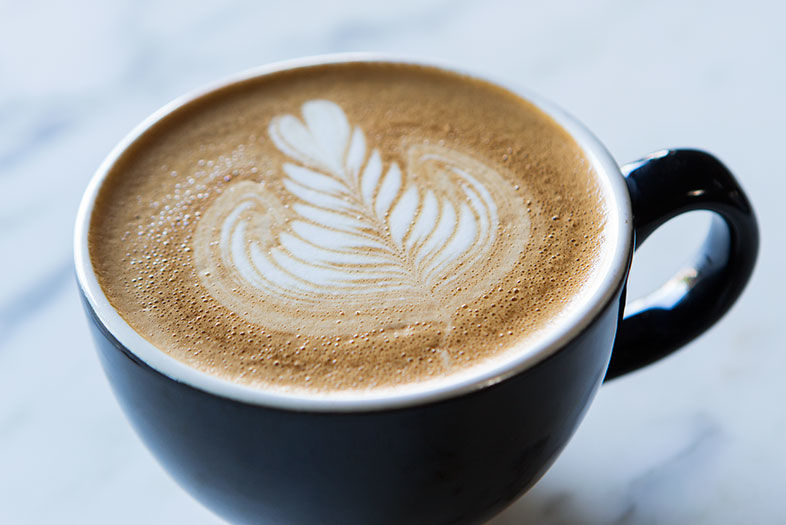As American coffee culture moves past the nonfat vanilla lattes toward a more elevated brew (imagine a cuppa so artfully crafted that it’s meant to stand on its own, black, without the cream), San Diego is right on trend. Local roasters are raising the bar and finding that the competition is fierce.
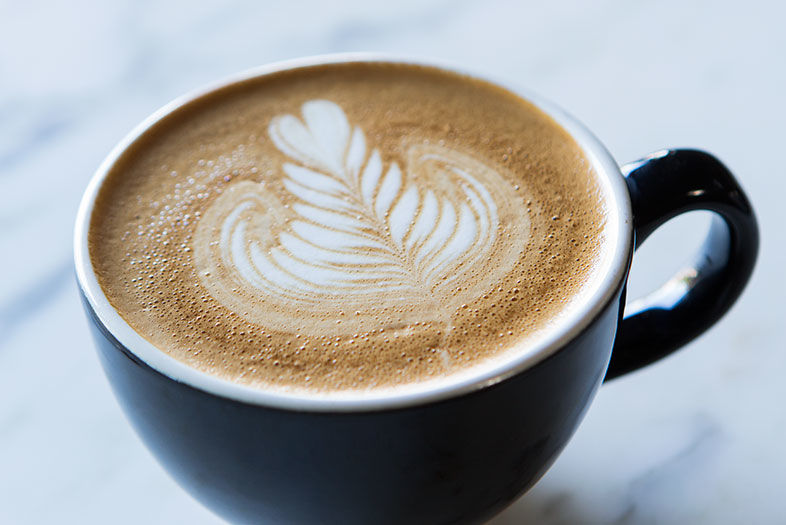
San Diego Coffee
Luis :Garcia

Daniel Holcomb
Daniel Holcomb, founder and owner of Coffee & Tea Collective
It’s just a cup of coffee. It’s the black, ubiquitous liquid that makes mornings hurt less or brings the afternoon a caffeine-laden second wind. Coffee has long been a beverage more mindlessly ingested than tasted and appreciated. All that is changing now. As foodies move toward fresh, organic, local everything, it’s only natural that the coffee industry—purveyors of something 63 percent of Americans consume daily—would catch on. Finally, coffee is joining the upper ranks alongside craft beer, cold-pressed juice, artisan cheese, and other high-brow food and drinks.
Modern coffee evolution can often be broken down into three phases. The first was a post-WWII surge that put Folgers and Maxwell House into most American mugs. This was mass coffee production on the grandest scale, sardining burnt grinds into cylindrical tins and creating a generation of drinkers of bland coffee. The second is attributed to Starbucks and Peet’s, companies that focused on espresso-based coffee drinks (think half-caf soy nonfat grande lattes, four pumps, no whip) and coffee that was labeled by country and region, similarly to wine.
The most recent phase, known in the industry as the Third Wave, is coffee craftsmanship of the highest level. Drilling down past sourcing and labeling beans by country, they’re sourced from specific farms. The dark roasts made popular by Starbucks are now manifesting into lighter, brighter roasts, more acidic and almost sour (though this isn’t a defining characteristic of the movement, just a result of it). New serving techniques also mark the arrival of the Third Wave: A pour-over is a slow-drip single cup of coffee made to order, where beans are ground and placed in a filter-lined ceramic funnel and hot water delicately drenches the grind. Siphoned coffee is brewed in an hourglass-looking device that uses heat and vacuum pressure to reverse-cycle (from bottom to top) hot water through coffee grounds. Cold brewing is an eight-to-12-hour process in which room-temperature water percolates through coarsely ground coffee.
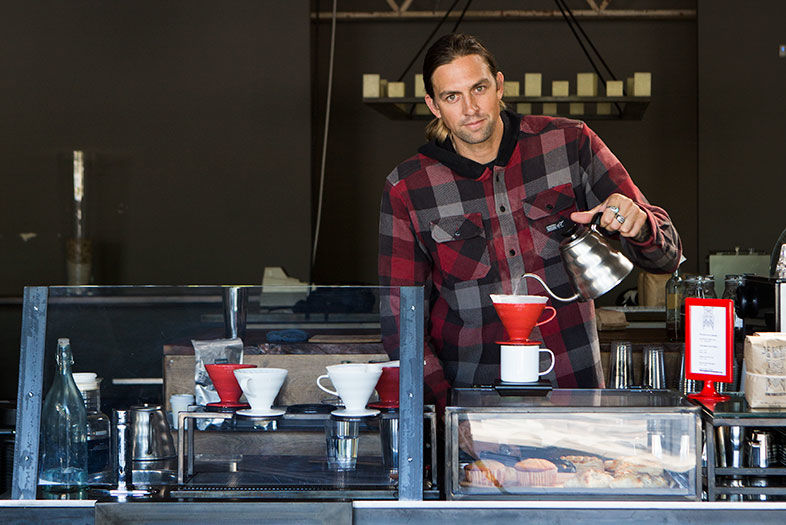
David Kennedy
David Kennedy pours over at James Coffee Co.
David Kennedy pours over at James Coffee Co.
Bonus: Click here to see a video of one of the Thursday Night Throwdown latte art competitions put on by the San Diego Coffee Network.
Third Wave may be a new term, but its concepts have been brewing for quite some time. San Diego is a relative neophyte to specialty coffee, but several roasters have paved the way for a coffee renaissance. One pioneer everyone points to is Arnie Holt of Caffé Calabria. Almost 23 years ago, Caffé Calabria began simply as a quest for a decent cup of coffee. A Seattle native, Holt set up coffee carts at Grossmont and Kaiser Hospitals before opening his Italian-accented North Park coffee shop and roasting operation. “I’ve been trying to pioneer Third Wave coffee for a long time,” Holt says. “It’s really good to see it happening because it’s where coffee should be.”
Café Moto (which began as a division of Pannikin Coffee) and Ryan Brothers are both Barrio Logan stalwarts that helped to get San Diegans thinking about coffee and appreciating locally roasted product. But despite these businesses’ efforts, not much national credence was given to our coffee scene until Bird Rock Coffee Roasters was named “Micro Roaster of the Year” by Roast Magazine in 2012.
With a focus on single-origin, seasonal coffee, Bird Rock Coffee Roasters opened in 2002. At the time, the roaster and coffee shop’s focus was different than its contemporaries, giving attention mostly to blends. Owner Chuck Patton opened his storefront right across the street from a Starbucks. “People thought we were crazy,” he remembers. It was almost poetic, though, ushering in coffee’s Third Wave kitty-corner from the international conglomerate. “In the last year and a half, [we’ve seen that] people will seek out good coffee,” Patton says. “That’s a huge thing that started happening. The city is starting to appreciate good coffee.”
By “good,” the experts are referring to a taste so sophisticated and flavorful that it can and should be drunk black. Hold the creamer.
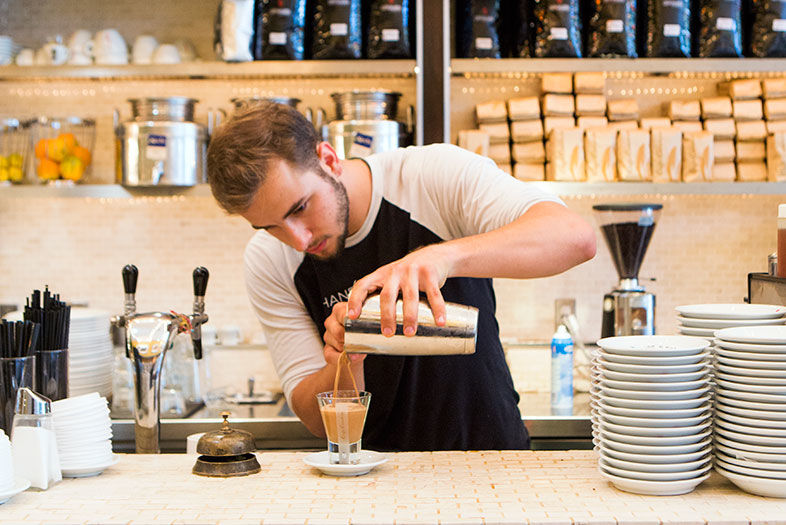
Jonathan Britton
Jonathan Britton experiments with an iced custom blend of five different single-origin coffees at Caffe Calabria
Jonathan Britton experiments with an iced custom blend of five different single-origin coffees at Caffe Calabria

Wake Up And Smell the Coffee
Luis :Garcia
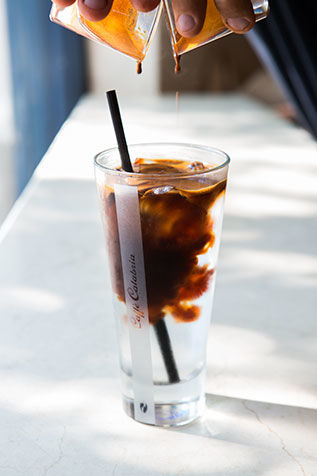
Wake Up And Smell the Coffee
Luis :Garcia
The proof is in the numbers. According to a recent study by the National Coffee Association on coffee drinking trends, overall coffee consumption in America increased by five percentage points, to 83 percent, in 2013. Single-cup brewing also saw a steady rise, from 37 to 43 percent, while consumption of coffee made in drip coffee makers declined.
Why only now is San Diego starting to sniff out good coffee? Whether it’s the consistently warm weather or the casual work vibe, San Diego falls far behind Seattle, Portland, New York, and the Bay Area in terms of a thriving coffee culture.
Craft beer, on the other hand, is arguably our forte, and has opened the floodgates to supporting small-batch, locally made products. Its spillover can be seen throughout the food and drink scenes, but especially in beverages like craft cocktails and coffee. Partnerships between brewers and roasters are numerous, furthering an unquenchable thirst for specialty coffee. In the Venn diagram that is coffee and beer, these collaborations land squarely in the middle: Coronado Brewing Company’s Blue Bridge Coffee Stout with Café Moto roasted coffee, Karl Strauss’ Wreck Alley Imperial Stout with Bird Rock Coffee Roasters, and Ballast Point’s Victory at Sea Coffee Vanilla Imperial Porter with Caffé Calabria coffee.
Just as the craft beer boom spread like wildfire, micro-roasters are popping up everywhere. One of the best known is Coffee & Tea Collective in North Park, named one of the “21 Hottest Coffee Shops Across the U.S” by Eater.com. Opened in 2012, the coffee shop thoughtfully sources single-origin beans and small-batch roasts, and focuses on a by-the-cup experience. With Zen-like precision, filtered water temperature is measured, coffee is weighed (about two tablespoons for every six ounces of water), and time is taken to ensure that each cup is specifically made for the drinker. Similar to in the craft beer world, Coffee & Tea Collective put its cold brew on tap. You can even fill up a growler of the stuff, coffee concentrate specifically, that’s meant to be mixed with water and served over ice. “It was a very interesting transition for new people coming into the shop. Talking to people, the [coffee] language was different than what they were used to,” says Michael Spear, curator of experiences at Coffee & Tea. “Now we have regulars and people who bring in their friends. We’re a destination coffee spot.”
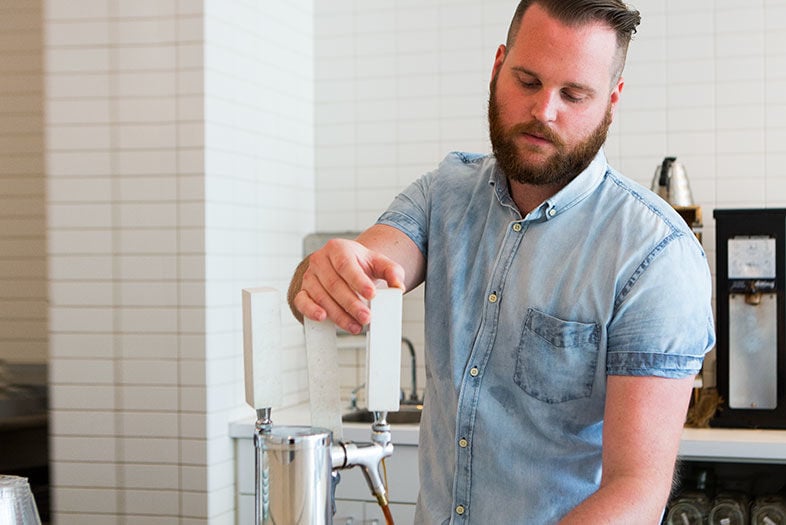
Michael Spear
Michael Spear at Coffee & Tea Collective serves up cold brew on tap
Michael Spear at Coffee & Tea Collective serves up cold brew on tap
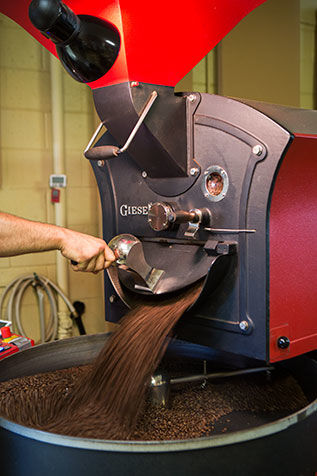
Wake Up And Smell the Coffee
Luis :Garcia
Other local roasters have continued to pop up, with a focus on small-batch roasting (giving the roaster ultimate control over the bean) and serving techniques that aim to present the coffee in its truest form. Dark Horse Coffee Roasters in Normal Heights has gained quite a following, expanding to Golden Hill and Truckee, California (near Lake Tahoe). WestBean Coffee Roasters is getting its first brick-and-mortar location downtown to complement the Mission Valley roasting facility. Café Virtuoso in Barrio Logan sources 100 percent organic beans, and was recently named “Best Small Business” by the California Restaurant Association. Farther north, Lofty Coffee and Revolution Roasters in Encinitas both employ Third Wave principles, sustainably sourcing beans from all over the world. Mostra Coffee in Rancho Bernardo produces a cold brew that fans compare to manna of the gods.
Even rock stars are riding the Third Wave. David Kennedy, guitarist for the internationally touring band Angels and Airwaves, started James Coffee Co. out of his garage, roasting on a popcorn machine. He’s now selling his beans online at a boutique kiosk in Little Italy. Cura Coffee is a direct trade coffee roaster started by Thomas Fitzpatrick, a local dentist who traveled to Nicaragua to provide dental care but came back with the coffee bug. While in the town of Boaco, the team Fitzpatrick was traveling with found a wealth of small farms growing high-quality coffee, and he now works directly with the farmers to source the green, unroasted beans.
If craft coffee is a fire, the San Diego Coffee Network is the one stoking it. Started by a coffee blogger Jessica Percifield, barista Matt Barahura, and videographer Jared Armijo-Wardle, the association hosts events that bring the coffee community together. At its Thursday Night Throwdowns, what sounds more like a WWE title belt match is actually a series of latte art competitions with 100-plus attendees. Small, quiet coffee shops morph into high-energy, jam-packed venues of onlookers watching baristas paint with milk on a coffee canvas. The group hopes to bring attention to our local coffee scene and unite coffee enthusiasts and professionals.
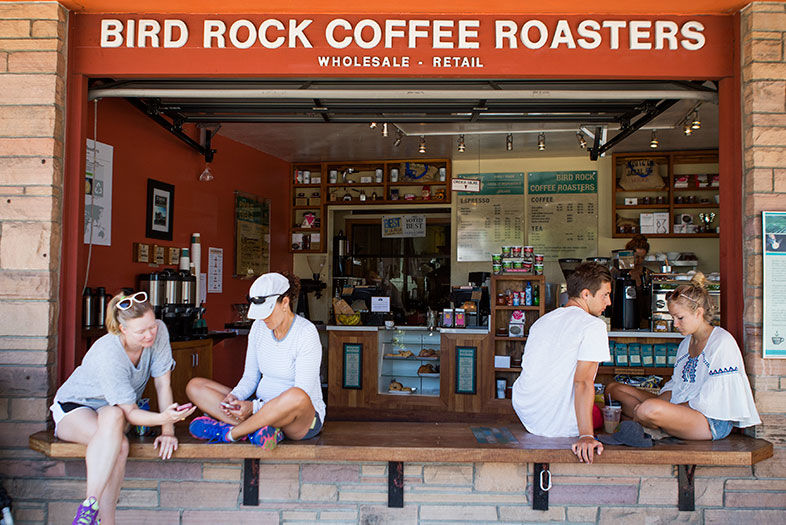
Bird Rock Coffee Roasters
Luis :Garcia
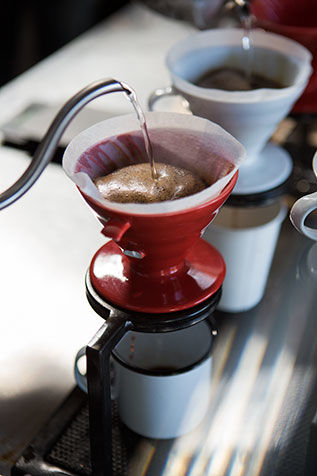
Wake Up And Smell the Coffee
Luis :Garcia
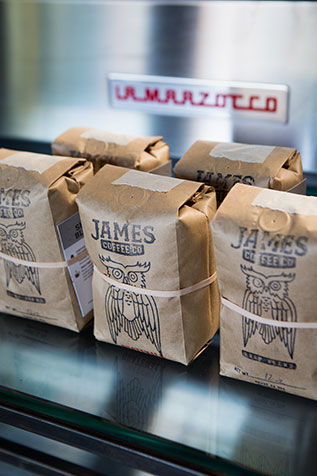
Wake Up And Smell the Coffee
Luis :Garcia
Unlike the craft beer scene, though, local roasters don’t share ingredients or recipes and aren’t collaborating much, due to the nature of selling coffee. “Go to any new bar in town,” says Chuck Patton of Bird Rock Coffee Roasters. “It’s going to have lots of taps, so breweries can share a single account. But coffee isn’t really like that—you can’t share wholesale accounts.” There’s an underlying competitiveness and survival instinct to the coffee industry, of which most drinkers are unaware. And while the San Diego Coffee Network aims to table the politics, if just for an evening, to shine a light on a growing industry, Patton says it’s sourcing that really separates the crème de la crème of Third Wave roasters. “It’s terrific how many roasters are putting time and energy into quality coffee. But more effort needs to be placed on sourcing green beans. It’s crucial for the long-term success of San Diego coffee,” he says. “It’d be great to see more people making the effort to go to origin. There’s time to do that. The coffee industry is rather young but we should be working towards sourcing.”
And this is just scratching the surface. Each year, consumption of these specialty coffees continues to rise, wedging open the door for quality coffee responsibly sourced and precisely prepared.
Coffee Talk
Learn the lingo of “Third Wave” coffee culture
Single origin refers to where the coffee was grown. This once referenced the country of origin, then a particular region of the country. Now, certain farms or a co-op of farms or estates are noted, as with wine, and terroir is often considered.
Small batch and micro roasting are symbiotic terms more commonly seen as “small batch roasting.” As with craft beer, it depends on the size of the roasting equipment rather than the amount of coffee roasted. A roaster in the 25-lb. region is mostly considered small batch roasting. Reaching more than 100 lbs. is considered macro-level roasting.
Fair trade coffee is a certification. It fosters sustainable farming (of the coffee) and financial health of the small farmers and producers growing coffee, often in underdeveloped countries. It aims to distribute profits to stimulate economic growth, encourages ecologically responsible farming, and promotes fair working conditions.
Pour-overs are cups of coffee made individually. Beans are ground for a single cup and brewed in a cone dripper by meticulously pouring hot water over the freshly ground coffee, allowing it to drip into the cup from which it will be drunk.
Cold brew is not iced coffee. Coffee grounds are steeped in room-temperature water for a period of 12 to 24 hours. This results in a less acidic coffee with higher caffeine content and nuanced flavors, usually mixed with water and served over ice.














